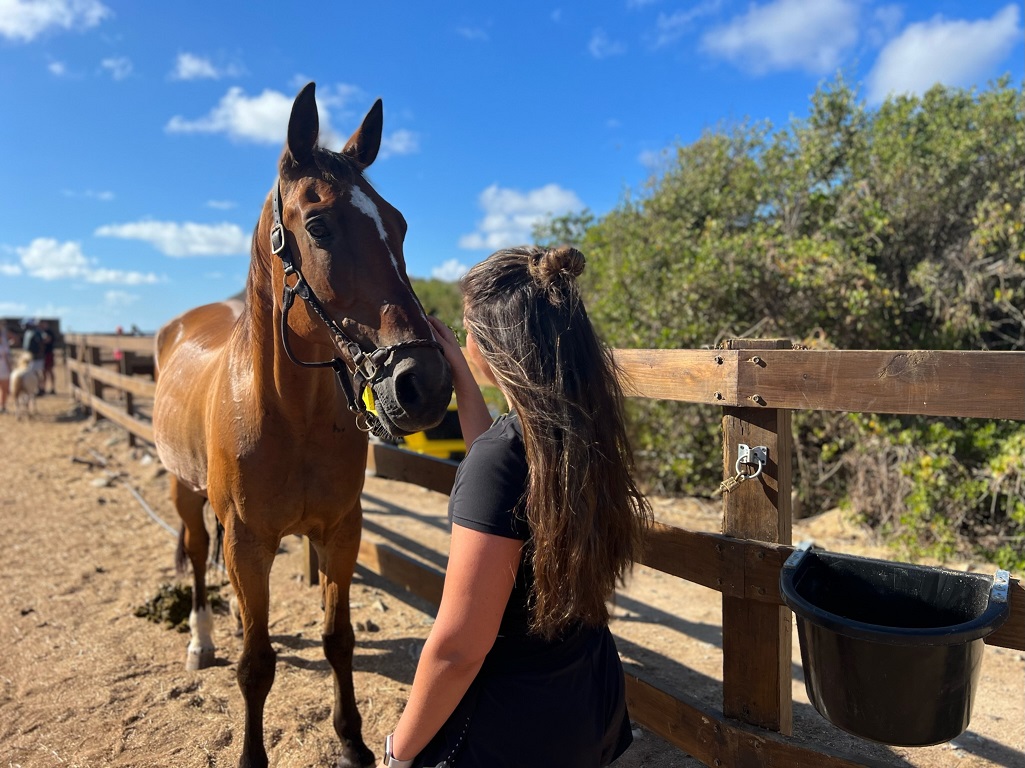Horses are truly gentle giants that have a calming and often therapeutic presence, and studies continue to show that, when used in rehabilitative care, hippotherapy (horse-therapy) can improve a person’s self-esteem, coordination, fine motor skills, and overall quality of life.
While horses have provided companionship for millennia, the modern concept of hippotherapy focuses on the use of a horse’s movements to treat people with mental or physical disabilities, or emotional trauma. Hippotherapy is a tool employed by occupational therapy, physical therapy, and speech language pathology professionals, and is also offered by some luxury wellness resorts to help guests find deep healing for body and mind.

What Is Hippotherapy?
Hippotherapy comes from the Greek word “hippos,” which means horse. Hippotherapy translates literally to “treatment with the help of a horse”. Essentially, it is a client-centered occupational therapy tool that uses horseback riding (equine movement) as an integrated intervention to improve mental and physical health conditions.
In a hippotherapy session, an individual rides a horse using various gaits to strengthen weak muscles and joints, improve postural control and gross motor skills, and enhance neurological functioning. The rider is accompanied at all times by the therapist, who usually leads the horse, and a second therapist or helper who helps to ensure that the rider doesn’t fall off.
Who Is Hippotherapy For?
Hippotherapy is an inclusive therapy designed for anyone who feels gravitated toward horses. Even those who may feel intimidated by horses may be surprised at how quickly they adapt to an equine therapy setting.
As evidenced by experience and research, therapeutic horseback riding and hippotherapy have beneficial effects on several human conditions including social, cognitive, learning, psychological, and adaptive behaviors and issues. In addition, equine movement may help individuals suffering from cerebral palsy, multiple sclerosis, arthritis, and a range of behavioral and psychiatric disorders.

Why Is a Horse Such a Powerful Treatment Tool?
It is thought that a horse’s gait serves as a way to improve balance, strength, and sensory deficits. Hippotherapy can also be an excellent treatment tool for nonverbal children, as riding a horse is an exciting experience and can motivate a nonverbal child to communicate. What’s more, the interaction that occurs between a rider and a horse during a hippotherapy session can help the participant build more confidence and self-esteem.
What is the Difference between Hippotherapy and Equine Therapy?
Equine therapy, more formally known as Equine Assisted Therapy (EAT), is a type of occupational therapy that incorporates a horse’s distinct characteristics to promote physical and emotional well-being. Generally, equine-assisted therapy is performed in a stable setting with trained occupational therapists. During an equine-assisted therapy session, the participant is asked to perform duties to help take care of the horse.

Examples of activities a participant may be asked to engage in during equine-assisted therapy could include:
- Grooming a horse: brushing away dirt and debris, cleaning and picking out hooves, and combing through the mane and tail
- Feeding a horse: offering a horse a sweet feed of good pasture, chaff, or hay
- Leading a horse: In a safe environment with a trained therapist, a client learns to walk a horse by steering and controlling the horse. This can be done with a leash or while horseback riding.
Like hippotherapy, equine-assisted therapy is a treatment strategy that uses equine activities to encourage physical and emotional growth in participants. And, since both therapies involve horses, sometimes the terms “equine-assisted therapy” and “hippotherapy” are used interchangeably.
However, the difference between hippotherapy and equine-assisted therapy is that the former is a specific type of equine therapy that focuses on using a horse’s natural movements to provide physical therapy and emotional rehabilitation to individuals with neurological problems, mobility issues, or other functional disabilities. In contrast, equine-assisted therapy focuses on stable-based activities relating to horse care.
How Effective is Hippotherapy?
The benefits of participating in hippotherapy extend beyond physical health. This treatment tool can also foster psychological and socialization skills. A literature review published in the Northern Clinics of Istanbul Journal in 2015 shows that completing a course of several hippotherapy sessions can benefit a participant in the following ways:
- Shorten recovery time for individuals who suffer from spinal, neck, or head injuries
- Activate muscle control and improve human pelvis strength
- Stimulate muscles and joints in children with cerebral palsy
- Help with sensory stimulation and sensory functioning
- Encourage the rider to develop good posture and proper balance
- Has a favorable effect on social, cognitive, and adaptive behaviors
Today, there are 813 therapeutic riding centers across the world where children, adults, and veterans find a sense of peace while working with horses. And that’s just the beginning. As the benefits of therapy involving horses become more evident, hippotherapy alongside other equine-assisted therapies such as EAT and horseback riding therapy will continue to expand in both clinical and non-clinical settings.

Where Can I Find Hippotherapy?
Hippotherapy is quickly gaining momentum because of its positive impact on participants. For some, hippotherapy has been a game-changer for either improving their own physical well-being or remediating the physical health of a family member.
Whether it’s for yourself or a loved one, finding skilled and licensed healthcare professionals trained in hippotherapy is the first step to experiencing this powerful treatment tool. The American Hippotherapy Association (a 501(c)(3) non-profit organization) offers a directory of trained certified and noncertified physical therapists in the United States who incorporate hippotherapy into their practices.
If you’d prefer to try hippotherapy in a non-clinical setting, hippotherapy is starting to pop up as a treatment tool that’s offered at wellness retreats, including on Redemption Ranch at The Aerial, BVI. Trying out hippotherapy or equine movement therapy for the first time in a relaxed atmosphere (such as a retreat center) can be a great opportunity to connect with nature and reduce your anxiety and stress levels as part of your personal wellness journey.
A Great Therapy Horse Can Change Your Life
Undoubtedly, there is something special about horses, and hippotherapy offers you the chance to heal using equine movement as physical medicine. The evidence is there: Horses can be used as a powerful therapeutic tool to enhance emotional and physical wellness, and this modality is gradually becoming available to people all around the world.
If you’re looking for an amazing way to restore your health, tuning into a horse’s movement with hippotherapy sessions can form part of an effective treatment plan. Not only can a great horse help you achieve greater health, but hippotherapy as a treatment tool can also help you tap into your confidence and inner strength and become the best version of yourself.
So saddle up and get excited, your optimal health awaits!